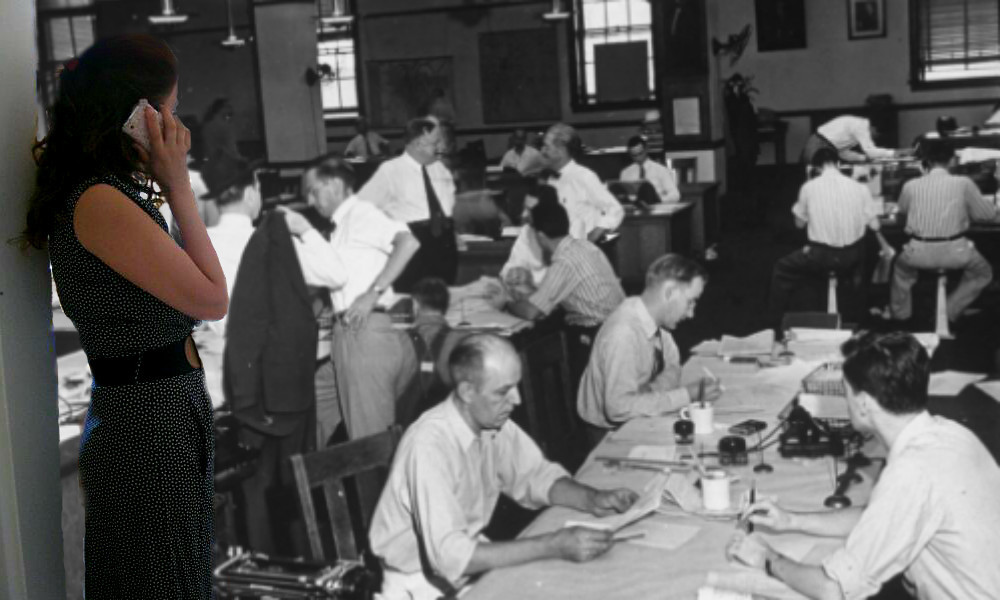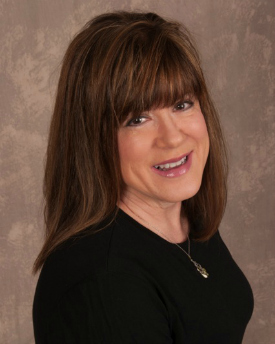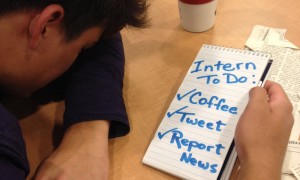
Carolyn Ryan of The New York Times told an anecdote recently that helped me think more clearly about this moment in time for women leaders in journalism — and made me appreciate that I wasn’t alone.
Ryan, head of the Times’ Washington bureau and a veteran leader of large departments in other newsrooms, described an incident at one of those big jobs that painted a stark picture of what many see as the difference between men’s and women’s leadership styles.
“Things were going pretty well. We had run some big stories. We had won some big prizes. All the feedback was positive. Then, one person took me aside and said, ‘You’re doing great, but I haven’t seen you stand up on the desk, Ben-Bradlee style, and really make the newsroom roar – loudly.’”
Her critic’s statement revealed a fantasy about journalism leadership more fit for Hollywood than reality. It’s one that reinforces journalistic legends that shut a lot of people out — like the way old Westerns offer the narrowest of narratives about power politics on the prairie. It also could be seen as a subtle way of undermining Ryan’s confidence.
“First of all, I don’t have a great sense of balance,” Ryan told more than 100 women gathered for a National Press Club-Poynter forum on closing journalism’s gender gap, to laughter. “Secondly, I don’t think I have the right shoes for desk-climbing.
“But I also started to think a little bit about what our image is of newsroom leaders and how it can be confined and handcuffed, and in my view, overly shaped by somewhat outdated notions of male leadership.”
And there it was — the thing I’ve been thinking about for years — how women can best negotiate power as they reach the highest echelons of journalism. During my own recent stint as a newsroom manager, I struggled with striking a balance between being a demanding leader and a force for creativity in a positive — and dare I say it — nurturing environment.
As we worked collaboratively on digital products in which we were all experimenting, mistakes were inevitable and even encouraged in the interest of innovation. I wanted to experiment, too, with leadership. At this time in history, the move away from the top-down, one-voice-to-all media model seems a natural fit for power-sharing in news organizations.
The Female Elephant in the Room
Ryan didn’t mention the recent shakeup at the top of her own newspaper – the firing of executive editor Jill Abramson. But Abramson’s situation, like no other recent event, appears to have galvanized women leaders in journalism nationwide, many of whom have experienced comments similar to those leveled at Ryan and heard descriptions — tough, mercurial, and yes, hard-charging and demanding — used for Abramson.
Abramson was a symbol for women in journalism, demonstrating that “you can go far,” said Martha Allen, director of the Women’s Institute for Freedom of the Press in Washington.
“Jill Abramson made a tremendous impact for the time she was there,” added Allen. “She brought a lot more women into The New York Times and that is crucial for future change.”
Some women also believe topics and approaches at the Times changed under Abramson, resulting in better journalism, according to Allen.
With that much promise at stake, women and their allies took it personally when it looked like Abramson’s importance was discounted so publicly.
“The way she was fired raised consciousness and a lot of discussion about how women have to behave versus how men behave,” Allen said. “There have been so many cases of men where their tough, rough, gruff stand has been acceptable. The attitude was, ‘That’s just the way it is.’ Some women and men may have liked that to change but that was a given. Then a woman in that position is not the self-effacing woman and she’s fired.”
Yes, we’re having a moment. Feminists may dispute how big of one — academic feminists tend to look beyond single events and focus on the underlying structures that create inequality, such as notions of privilege and broader economic and social issues. But it’s one that has risen above tired debates and made other women journalism leaders realize no one is immune from the type of criticism designed to undermine them as leaders. Women’s private battles at the highest levels are out in the open.
Forty Years of “Women’s Issues”
It’s also a moment I’ve been waiting for since my first reporting job in 1975 when I learned that the man who was hired at the same time was making more money, though we both had the same amount of experience – none.
The modern women’s movement by that time had certainly entered the national consciousness. It was two years after Roe v. Wade, three years after the Equal Rights Amendment was sent to the states for ratification, two years after Billie Jean King won the “battle of the sexes” on a tennis court and a year after the Supreme Court’s Corning Glass Works v. Brennan case supporting equal pay for equal work.
The newspaper’s executive editor told me that as a woman just out of college, surely I was getting help from my parents or husband, so I didn’t need as much as a man who might have to fund a household. (He later relented and upped my salary.)
It’s the thing I’ve been waiting for since I was told by male colleagues two years later that my new, higher-paying job at an international wire service came about because I was a woman. Which was it? I deserved low pay because I was a woman? Or I got higher pay because I was a woman?
I had been a trailblazer as a police reporter, though I didn’t know it at the time. I went on to be an editor in four major cities, a reporter on Capitol Hill (where I got used to being one of the few women in the hearing room while covering the passage of the Intermediate-range Nuclear Forces Treaty), and a television news writer before going to graduate school. I decided that off-hours employment and even getting a Ph.D. would allow more flexibility for raising a family than full-time reporting. Stop and think about that last sentence for a minute. I have a doctorate at least partly because I felt working part-time and going to graduate school was more conducive to child-rearing than being a full-time working mother.
Observing the “Tough, Rough, Gruff” Approach
From my first job, it took some 35 years before I would run a newsroom, but I saw a lot of men do it in the interim.
Once, I watched while the managing editor of my paper got red in the face, threw down a sheaf of copy and started yelling along the lines of:
“We’ve got a big printing press in the basement. We’ve got a bunch of desks around this room. We have a train track out back that brings giant reams of paper to our back door. WOULDN’T THIS BE A CONVENIENT PLACE FOR A NEWSPAPER, IF I ONLY HAD A DECENT REPORTER WHO COULD ACTUALLY DO HIS JOB!”
To be honest, we idolized him – he knew how to rally the troops in the best Ben-Bradlee style. We also feared him.
Later in my career, there were stories of editors throwing typewriters out of windows and getting in fisticuffs with reporters, though raised voices were the most common order of the day.
But I also had managers who were inspiring mentors and friends. In all these decades, few were women. Two female supervisors I did have were both let go (in what was blamed on reorganizations) and replaced by men. No wonder my first thought when Abramson was named executive editor was, ‘She won’t be around long.’
Studies Show Progress by Women in Journalism Leadership has Stalled
By the Women’s Media Center’s calculation this year, 36 percent of the journalism workforce is comprised of women, while women make up 23 percent of journalism leadership and earn 25 percent less than men in the same positions. Women do better in middle management, but there is a blockade at that level globally. This is not just in journalism, mind you, but that doesn’t make me feel any better.
In top journalism companies, women comprise only 10 percent of the leadership, the center found. In 1982, women made up 10 percent of the leadership positions in newspapers.
When you get to 2012, that climbed to 19 percent (22 percent in television and a dominant 55 percent in social media), but only four women serve as editors-in-chief of the nation’s top 25 newspapers, according to the WMC. Such numbers amid turmoil in the industry have created a lot of discussion and efforts at reform, but no one seems to disagree that diversity is lacking. (A new survey by the American Society of News Editors shows minority employment just over 13 percent in newsrooms in 2013, a percentage point higher than the previous year and just short of the record high of 13.73 percent in 2006.)
“We know an unequal workplace is not a new thing,” said Barbara Friedman, associate professor at the School of Journalism and Mass Communication at the University of North Carolina and editor of the scholarly journal, American Journalism. She focuses on research about women. “We know that groups have been studying this and trying to change this for centuries.”
The New York Times, itself, has been the focus of much study because of its stature within the industry.
“Studies of the Times’ book review, the editorial section, the front page, even obituaries have consistently revealed a gender imbalance. Men are represented more often than women as subjects, sources and authors,” said Friedman. “The New York Times has a very long history in terms of organizational makeup and newspaper content of being imbalanced. And for better or worse, this is the news organization that often sets the course for others.”
More than 20 years ago, ASNE set a goal of having news staffs mirror the American population in terms of minority representation by 2000. With that goal blown, it now has set a parity date of 2025.
Women on the Ground
Because women make up 64 percent of graduates in journalism and communication schools and are prevalent in the industry, according to figures compiled by the WMC, the drought of women in leadership may not be so obvious. As a graduate student, I studied the history of women and journalism, uncovering the decades of legal battles, activism, initiative and groundbreaking efforts, including with satellites and other technology used to publish and broadcast alternative feminist media.
But even I got complacent, thinking when I entered academia in 2003 that we were on a forward trajectory, especially with the digital disruption.
As a college professor, I pushed my students to learn new roles and fully embrace the democratizing nature of the new interactivity. The sense that journalism could be open to all and what I saw as the old, patriarchal model turned-upside-down was exhilarating.
When I had a chance in 2010 to enter digital journalism as a manager of journalists working remotely throughout Maryland at AOL Patch, I jumped at it. The news world was changing, and as a recently practicing feminist scholar it was my chance to experiment by bringing those principles to a traditionally male-dominated role in a progressive digital media company.
When a management challenge would arise, I kind of wanted to be Ben Bradlee – since that is some of what I had been exposed to – but, as Ryan pointed out, the shoes didn’t fit the situation, which in a fast-moving digital environment rife with change, called for a leader who could build trust one-on-one, deploy critical thinking skills and be a calm presence during times of chaos.
I did my best to empower those whom I managed. I often took a page, literally, from Jill Geisler’s book, “Work Happy: What Great Bosses Know,” which is as feminist a treatise as I’ve seen on the practical side of management in journalism. Geisler, who heads Poynter’s leadership and management programs and was a moderator at the Poynter forum, preaches collaboration, positive communication and a coaching method of leadership.
“I would make no apologies for the word feminism,” Geisler told AJR. “If it’s feminist, then it must be organically feminist,” based on Geisler’s belief that the first priority of a leader is to help other people succeed. “My slogan has always been life’s too short to work with jerks,” regardless of gender, she said.
I don’t want to ascribe certain behaviors to certain genders — I’m talking here about leadership style and the purposeful act of being a positive force and perhaps listening more and trusting talented people. When I was a newsroom manager, my employees were the ones who came up with the best ideas and the most effective solutions. I didn’t have all the answers; no manager does.
Rachel Smolkin, who is leaving her job as Politico’s managing editor of news to become executive editor of CNN Politics Digital, is looked to as one among a new generation of women leaders in a digital future. She told the panel that it’s helpful for women to be aware that the outside world sometimes expects them to smile more and be friendlier and more nurturing — advice she later said she and other women should feel free to ignore in favor of authenticity.
“I think women are just as capable of being mean,” she told AJR. “I just try and be honest with the people who work for me. If you don’t demonstrate that you have trust and faith in people by letting them do what they do, it doesn’t make for a very fun or easy place to work. That takes a lot of strength.”
Thinking Like a Man
Feminism is about understanding and disrupting power relations. When you’re a manager and you want an excellent product, it’s, as Smolkin said, a challenge.
Be all nicey, nice and you risk losing credibility. Be hard-charging and risk being called a bitch or booted — as those watching the Abramson situation feared happened to her. We don’t know all the facts of Abramson’s firing and perhaps don’t need to. She is the lens through which I and other women see themselves, making her situation all the more interesting.
Barbara Barnett, associate professor and associate dean in the William Allen White School of Journalism and Mass Communications at the University of Kansas, has studied feminist leadership. She remembers a conversation during her time at a newspaper in which a new female manager had come aboard. The six male managers involved declared that the woman would succeed “because she thinks like a man,” Barnett said. “I was stunned. There’s already a dichotomy set up. You have to be one of us.
“We’ve got this idea in corporate America – a vision of what a manager should be. Frankly, sometimes that’s being a bully. You can lead without being a bully.”
Barnett said that women journalism students see the inequities that women who were pioneers in the field perhaps didn’t. As Barnett describes it, these young women still have anxiety about gender and journalism, but maybe they have a perspective that means they’ll get leadership right — in the way Smolkin described.
“A female journalism student came to me in tears, ‘It really is a man’s world.’ What am I going to tell her? ‘Oh, no, it’s not?’ I see it every day. The fact that you’re in college, the fact that you recognize this, you will be able to take charge of your own destiny. When I was in college it wasn’t necessarily clear that I could do that.”
For the most part, I feel good about my 3 1/2-year experiment as a feminist news manager. I got positive feedback from some of those I managed. I worked hard at it, but in the heat of breaking stories, I raised my voice a couple of times, and later apologized.
Some of the same words used to describe Abramson were at times used to describe me, I’m sure — a phenomenon outlined eloquently by Susan Glasser, editor of Politico Magazine, and others immediately after Abramson’s firing.
“In the end, just about every single thing that has been said about Jill Abramson and Natalie Nougayrède (former executive editor of Le Monde) was also said about me,” Glasser wrote. “That I was difficult and hard to understand and divisive. That there were questions of ‘management style.’ Places like the New York Times, Le Monde and The Washington Post are not given to elevating editors—of any gender—who would accept anything other than the highest of standards. As in tough, demanding, challenging. But there’s no doubt that many find this off-putting and threatening from a certain kind of woman. Like me.”
Read more: Editing While Female
Smolkin noted Glasser’s call for companies to go beyond putting women in high places by supporting them in those roles, particularly when they fail at some things.
“One of the things she talks about is how important it is to support women in these positions so they have the space and freedom to innovate, to experiment and most importantly to make mistakes …. Are you going to withhold your support, say, ‘Oh, they’re not temperamentally suited for this job’ – a term women hear probably more than men, or are you going to stand behind them and back them?” Smolkin told the panel.
Of course, there are exceptions in the media world — Arianna Huffington and Tina Brown come to mind. But for anyone still doubting whether women face particular problems as leaders, Smolkin pointed out Matt Lauer’s recent interview with General Motors chief executive Mary Barra, who has decades of experience but who was subjected to questioning on whether she was hired to “soften” GM’s image and if she could do the job and also be a good mom — questions not asked of men.
Abramson’s Own Words
Abramson, herself, pooh-poohs the idea that her singular situation is that big a deal. In an interview with Katie Couric on Yahoo News, she made no apologies for being “hard-charging.”
“I think that women are scrutinized and criticized in a somewhat different way and that certain qualities that are seen in men as being the qualities of a leader … are somehow not seen in as attractive a light when a woman is involved. I’m hardly the first person to observe that.”
Abramson also downplayed her role as a symbol.
“Let’s be honest. How many people in the real world really care about why Jill Abramson lost her job?” she said. “They should care about, is the New York Times strong? Is the news report fantastic and great? That is what I delivered on both as managing editor and executive editor.”
Friedman said Abramson has a point.
“The New York Times is not representative of most workplaces and Jill Abramson is not representative of most working women,” Friedman said. “However, this high-profile firing has amplified discussions across many groups in many places. Is it a watershed moment? Maybe. But certainly it’s a great opportunity to talk about workplace issues as part of a much broader economic agenda for women.”
Maintaining momentum, in the face of overall losses for women, should be the focus, say these women who study the history of women in journalism. Change is coming on many fronts, Ryan told the forum:
“To tell you the truth I’m thinking about it more and more these days because one thing that’s going on … is the next generation of leaders in my view is not going to have careers like mine,” Ryan told the panel. “A lot of the people who we’re going to be turning to are people who came in from the digital side and people who look very different in a whole number of ways from Ben Bradlee.
“They haven’t been swashbuckling reporters. They think about telling stories in multimedia fashion. They sometimes come to us from technology companies. It feels like to me the most urgent thing that I can do and that I can help The Times do is help to both identify and acknowledge and elevate styles of leadership that allow for a more creative team. That feels to me like a very pressing reality right now.”
Ryan, Abramson, women academics who study the history of women in journalism and many women who work in news are part of a generation that has pushed onward aggressively and competitively, with their foremothers’ help, for a long time.
Whatever their approach, they have all served as leaders or role models for the next wave of women and they stand as both a bulwark and bridge to a new era that they seem to be glad to help shuttle along. That’s why this is a moment — women speaking out on a feminist issue has become a focal point for debates within the industry about giving up outdated approaches of all kinds.
Ryan told AJR that after the on-the-table comment, she did what she advises women in leadership to do — seek the counsel of other senior women. She said she went to talk to the most experienced woman she knew at her then-news organization and asked if anything similar had ever happened to her.
“She said — ‘All the time.’”
And that needs to stop.
Danna Walker, Ph.D., a former senior regional editor for Maryland at Patch.com, is a freelance journalist working in Washington, D.C., and was a guest editor at AJR during the summer. She will be teaching writing in the fall at the School of Communication at American University.









Leave a Comment